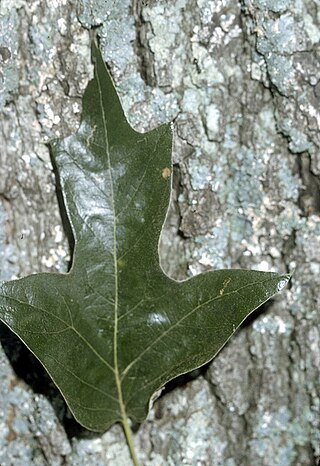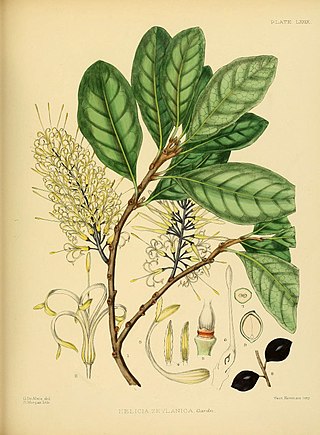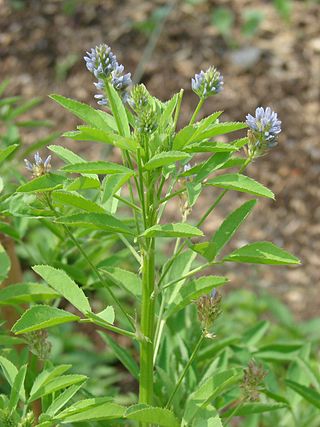
Medicago is a genus of flowering plants, commonly known as medick or burclover, in the legume family (Fabaceae). It contains at least 87 species and is distributed mainly around the Mediterranean Basin, and extending across temperate Eurasia and sub-Saharan Africa. The best-known member of the genus is alfalfa, an important forage crop, and the genus name is based on the Latin name for that plant, medica, from Greek: μηδική (πόα) Median (grass). Most members of the genus are low, creeping herbs, resembling clover, but with burs. However, alfalfa grows to a height of 1 meter, and tree medick is a shrub. Members of the genus are known to produce bioactive compounds such as medicarpin and medicagenic acid. Chromosome numbers in Medicago range from 2n = 14 to 48.

The falcated duck or falcated teal is a gadwall-sized dabbling duck from the east Palearctic.

Quercus falcata, also called southern red oak, spanish oak, bottomland red oak or three-lobed red oak is an oak. Native to the southeastern United States, it gets its name the "Spanish Oak" as these are the areas of early Spanish colonies, whilst "southern red oak" comes from both its range and leaf color during late summer and fall. The southern red oak is a deciduous angiosperm, so has leaves that die after each growing period and come back in the next period of growth.

Trigonella is a genus from the family Fabaceae. The best known member is the herb fenugreek. Members of the genus occur naturally in the Canary Islands, southern Europe, non‑tropical Africa, western and central Asia, the Indian subcontinent, and Australia.

The sicklefin houndshark is a rare houndshark of the family Triakidae, endemic to Western Australia. The holotype was collected from a depth of 150 metres (490 ft) Its reproduction is ovoviviparous.
Cynometra falcata is a species of plant in the family Fabaceae. It is found only in Fiji.
Chusquea falcata is a species of bamboo endemic to Ecuador.
Typhlocypris trigonella is a species of ostracod crustacean in the family Candonidae. It is endemic to Slovenia, where it is known only from Postojna Cave.

Helicia is a genus of 110 species of trees and shrubs, constituting part of the plant family Proteaceae. They grow naturally in rainforests throughout tropical South and Southeast Asia, including India, Sri Lanka, Indochina, Peninsular Malaysia to New Guinea and as far south as New South Wales.
Myrsine falcata is a species of plant in the family Primulaceae. It is endemic to French Polynesia.

Martellidendron hornei is a species of plant in the Pandan, or Screwpine family (Pandanaceae), one of several Pandanus species that are endemic to the Seychelles.

Amesiella philippinensis is a species of orchid endemic to the Island of Luzon in the Philippines. Like Vanda falcata it was mistaken as an Angraecum species, due to the white, long-spurred flowers. The plant produces rounded leaces up to 5 cm in length. Three or four white, fragrant flowers of 3 cm in width are produced on short inflorescences. The labellum is yellow in the throat. It occurs at lower altitudes than Amesiella monticola and has a shorter spur.

Quercus pagoda, the cherrybark oak, is one of the most highly valued red oaks in the southern United States. It is larger and better formed than southern red oak and commonly grows on more moist sites. Its strong wood and straight form make it an excellent timber tree. Many wildlife species use its acorns as food, and cherrybark oak makes a fine shade tree. Cherrybark oak was formerly considered to be a subspecies of southern red oak, Quercus falcata, subsp pagodifolia.

Crateva is a genus of flowering plants in the caper family, Capparaceae. It includes 21 species which range through the tropical regions of the world, including the tropical Americas, sub-Saharan Africa, the Indian subcontinent, Indochina, southern China, Japan, Malesia, Papuasia, Queensland, and the South Pacific.

Epinotia trigonella, the birch epinotia moth, is a species of moth of the family Tortricidae. It is found in most of Europe, east to the eastern Palearctic realm. It is also found in North America.

Vanda falcata, also known as 风兰 in Chinese, 풍란 (pungnan) in Korean, 風蘭 (fūran) in Japanese, or the wind orchid in English, is a species of orchid found in China, Korea, and Japan. It was formerly classified in the genus Neofinetia.

Trigonella suavissima is a herbaceous plant that is endemic to Australia. It is a member of the genus Trigonella and the family Fabaceae. Common names include Cooper clover, Menindee clover, calomba, Darling trigonella, sweet fenugreek, channel clover, sweet-scented clover and Australian shamrock.

Trigonella caerulea is an annual herb in the family Fabaceae. It is 30–60 cm tall. Its leaves are obovate or lance-shaped, 2–5 cm long, 1–2 cm wide and saw-toothed in upper part. Its flower stalks are compact, globular racemes, longer than the leaves. The sepals are twice as short as the corolla, its teeth are equal to the tube. The corolla is 5.5-6.5 mm long and blue. The pods are erect or slightly curved, compressed, 4–5 mm long with beak 2 mm. The seeds are small and elongated. It blossoms in April–May, the seeds ripen in May–June. It is self-pollinated.
Faguetia is a monotypic genus of trees in the subfamily Anacardioideae of the cashew and sumac family Anacardiaceae. It contains the single species Faguetia falcata, which is endemic to eastern Madagascar.
Trigonella maritima is a species of plant in the family Fabaceae.














